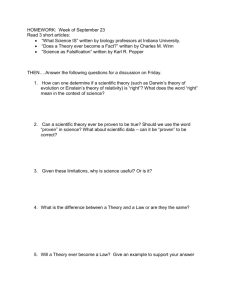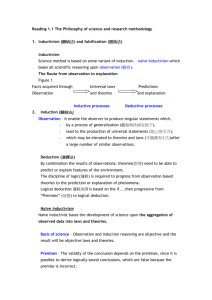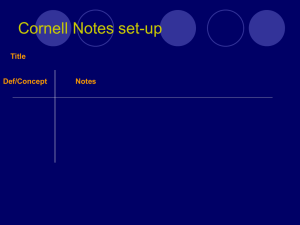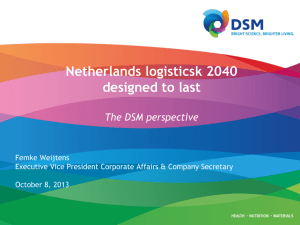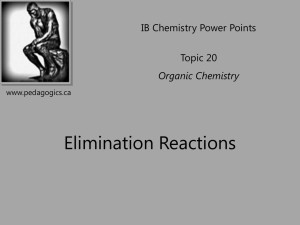Critical Thinking for Social Workers
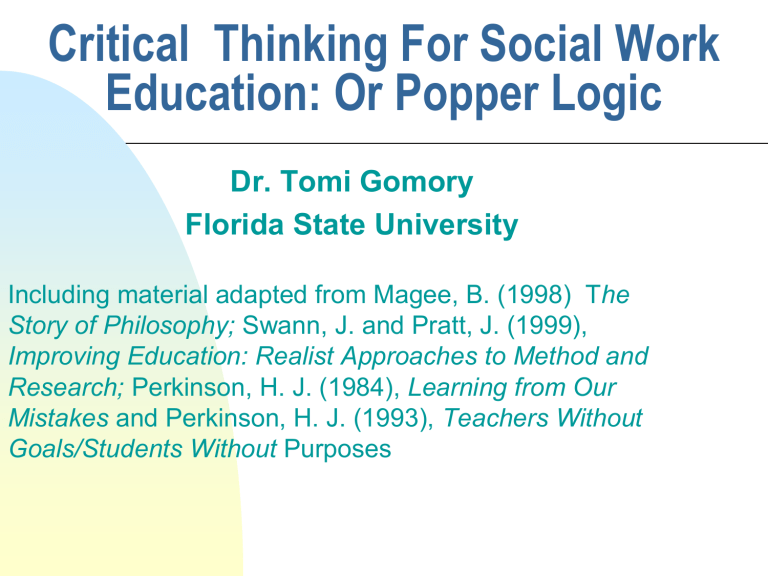
Critical Thinking For Social Work
Education: Or Popper Logic
Dr. Tomi Gomory
Florida State University
Including material adapted from Magee, B. (1998) T he
Story of Philosophy; Swann, J. and Pratt, J. (1999),
Improving Education: Realist Approaches to Method and
Research; Perkinson, H. J. (1984), Learning from Our
Mistakes and Perkinson, H. J. (1993), Teachers Without
Goals/Students Without Purposes
Purpose
What is the purpose of thinking about policy or practice-related questions?
If our purpose is to gain knowledge or help others by reducing or eliminating problems, then we must carefully consider our beliefs and actions.
Critical thinking requires testing evidence.
Critical thinkers make a genuine effort to fairly critique all views, preferred and not preferred.
They value accuracy and rigor ( truth ) over
"winning" or social approval
.
Importance
Does critical thinking matter? Are clients likely to receive better services if social workers or other helping professionals use critical-thinking skills for example? These are some of the errors that may occur if incomplete or inaccurate perspectives are accepted:
• Misclassifying clients
• Selecting weak intervention methods (e.g., offering psychological counseling when clients need material resources)
• Increasing client dependency
• Overlooking client assets
• Causing harm where none may have been intended
Danger
Examples of harm based on thoughtless intervention and iatrogenic effects (helper-induced harm) include:
20-40% of psychiatric clients (tens of millions) taking antipsychotics have various movement disorders i.e. Tardive Dyskinesia (permanent organic brain damage) as a result (Breggin, 1997).
“Neither hypericum [St. John’s Wort] nor setraline
[Zoloft] could be differentiated from placebo on the primary efficacy measures.” ( a Double-blind, randomized, placebo controlled trial conducted at
12 psychiatric research clinics with an n=340.
Hypericum Depression Trial Study Group, (2002),
JAMA) with suicidality one of the many adverse effects of the antidepressant but no hypericum.
Cognition:
The Act or Process of Knowing
Truth: Is it “Absolute” (Objective) or “Relative”
(Subjective)?
Can we have “Objective Observations”? The human organism and its limits or can we read the book of nature due to its commonsense obviousness?
Are we Tabula Rasa (empty buckets ready for the filling) or do we have A Priori knowledge at birth ?
The Transmission
Metaphor
Education is a process of transmission by authority.
The teacher prepares the student, prepares the subject
matter, and transmits
(instructs, matches) the subject to the student in the form of lessons to be learnt.
The subject matter is what is transmitted; that which is
learnt.
The student is a learner, a more or less passive container who needs to be controlled and motivated externally.
The Growth Metaphor
Education an autonomous procedure of (Darwinian) growth: trial-and-error elimination; the continuous modification of existing knowledge.
The teacher creates an educative environment--an environment that is free, responsive, and supportive-wherein the student can improve
(modify) his present knowledge through trial-and-error elimination.
The subject matter is an agenda specifying what aspects of students’ current knowledge are to be improved.
The subject matter evokes present knowledge and tests it (revealing inadequacies).
The student is a fallible, active creator of knowledge who seeks order. When he discerns contradictions (errors) in his present knowledge, he will modify it.
The Two Frameworks of Knowledge Development
Justification
Uses Induction-An accumulation of atheoretical
(objective) observations to construct well-justified theories.
Theories are verified by the volume of support found.
Theories with more support are more credible than those with less support.
Knowledge grows by adding to the already well-justified evidence.
To acquire knowledge of the world you fill the empty bucket of your mind with sensory input of the commonsensically obvious observed world.
Falsification
Induction is a myth. No atheoretical observations are possible.
Accumulation of observations is never justified. The first counterexample found in the future vitiates all the well-justified and reliable prior evidence (i.e. Black
Swans).
Although you can never justify you can always attempt to falsify tentatively true theories or solutions. One logical counterexample can falsify previously “credible evidence”.
Knowledge is paradoxically gained through the elimination of false opinion, not through accumulation of “true” facts.
Formula for Critical Rational Thinking(CRT)-Karl
Popper 1902-1994
All learning begins with a problem.
P1-TT(TS)-EE-P2
P1 =A problem occurs when an individual experiences a mismatch between what she expects to occur and the actual experience which stimulates the person to attempt to resolve the discrepancy.
TT ( TS )=A tentative theory or trial solution with its own set of expectations is applied to the problem. Like the disappointed expectation (a tentative falsification) leading to the initial problem( P1 ) it provides further scope for the discovery and elimination of error( EE ) or inadequacy.
EE =Error Elimination: A rigorous test or argument is used to evaluate by attempted falsification the impact of the TT ( TS ) .
Feedback in the form of experience(actual and anticipated) reveals errors and inadequacies in an individual’s implicit assumptions and explicit theories.
P2 =The inevitable result of EE in trying to solve a problem
(P1) is a new problem ( P2 ) requiring attention.
This process is infinitely reiterative.
Critical Rational Thinking About “Mental Illness”
P Mental disorderliness-what is that?
TT- 1. Volitional troubling behavior to self/others a. Problems in living (groupings of socially undesirable habitual behaviors) b. Disvalued/deviant behaviors (labels)
2. Medical disease/disorder(DSM mental disorders) a. DSM definition b. Harmful dysfunction c. Diseases just like other diseases
(i.e. Cancer)
EERigorous evaluation of the results of the various conceptualizations through scientific research about the empirical realities of postulated entities and explanations, and broad critical debate of the positions held. The fact that according to the research literature and the DSM itself not a single DSM Mental Disorder entity has a physical marker should present serious concerns for those who claim that mental illnesses are medical disorders for example.
Next Steps
Primum Non Nocere :First and foremost do no harm
Always ask: Cui Bono? For whose benefit;
For what purpose?
De Omnibus Dubitandum : Doubt
Everything and
Carpe Diem : “Seize the Day” by enjoying and engaging in problem solving in the present world and not in planning for future
Utopias
